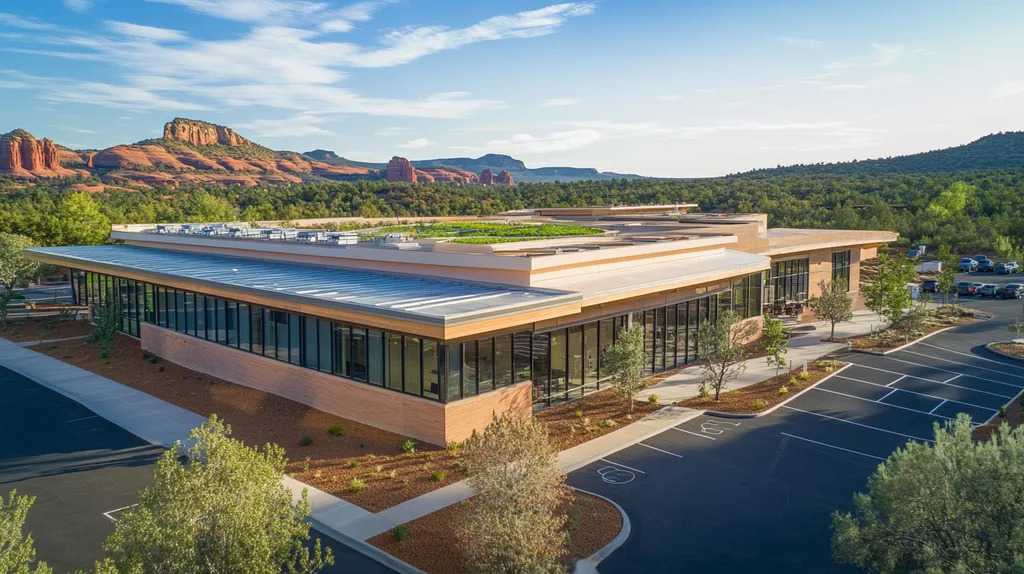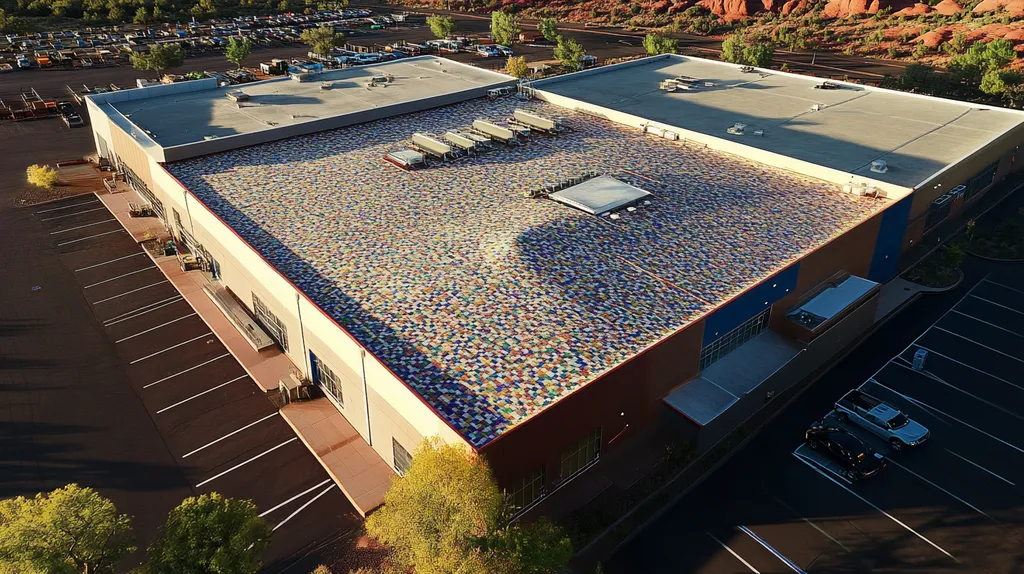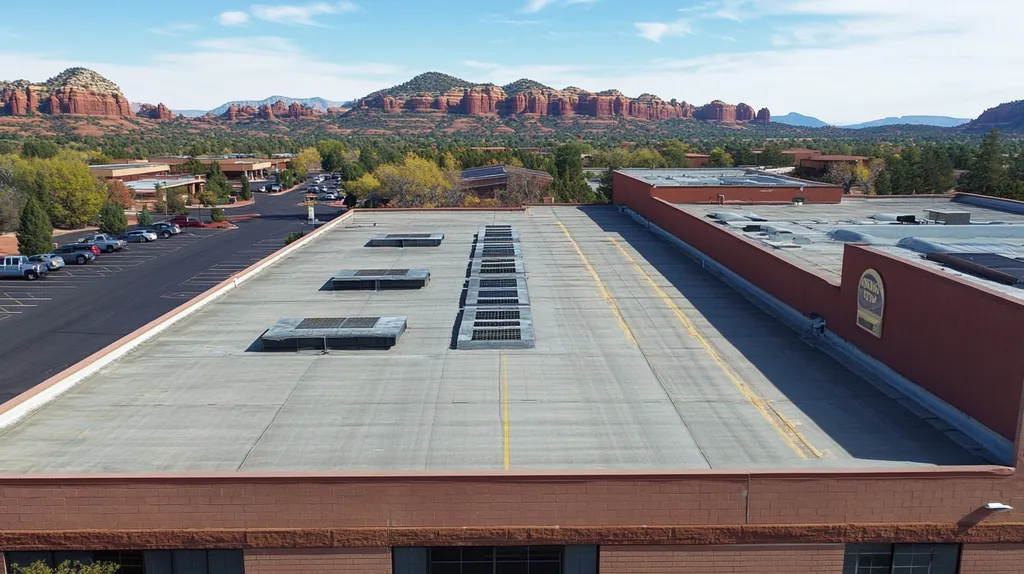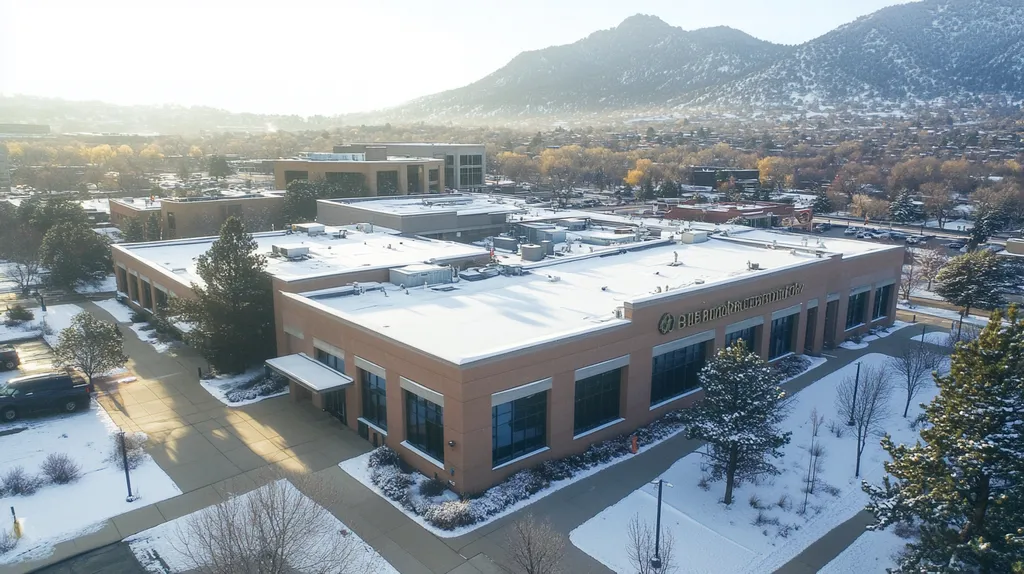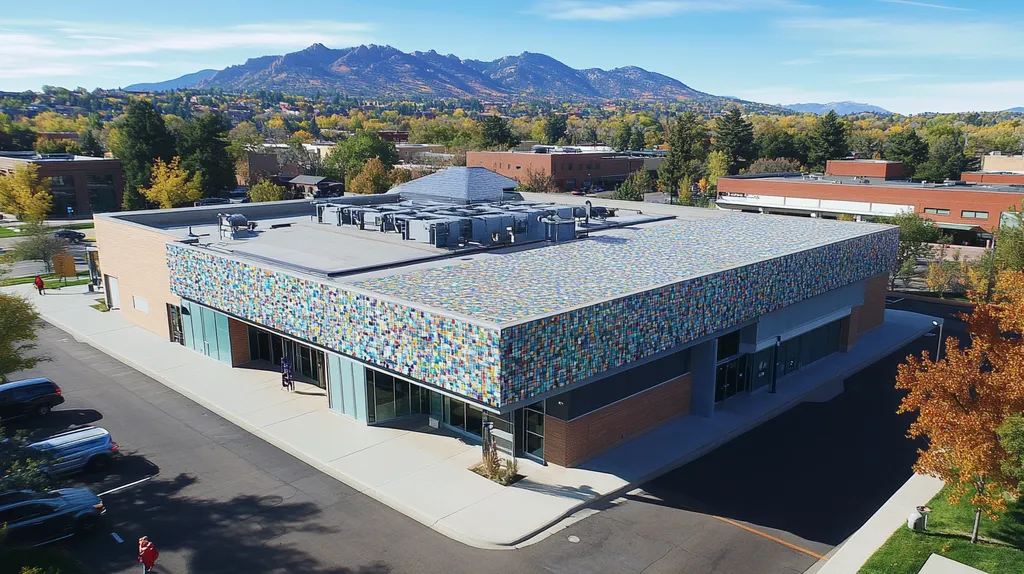In today’s industrial facilities, traditional dark roofs can reach temperatures of 150°F or higher during peak summer months, driving cooling costs up by 25% and accelerating roof deterioration. These challenges are prompting facility managers to seek innovative solutions.
Cool roofing technologies have emerged as a game-changing approach, offering the potential to reduce roof surface temperatures by up to 50°F while cutting cooling expenses by 30% annually.
This comprehensive guide explores the latest developments in industrial cool roofing, from reflective materials and coatings to implementation strategies and performance metrics, providing facility managers with actionable insights for sustainable roof management.
SECTION 1: FUNDAMENTAL CONCEPTS
As sustainable building practices gain momentum, cool roofing technologies have established themselves as essential solutions for industrial roof systems. With climbing temperatures leading to heightened energy costs, property owners must tackle the challenges of roof efficiency. By adopting cool roofing, businesses can effectively combat these issues, enjoying benefits such as reduced cooling expenses and enhanced indoor comfort.
Definition and Benefits of Cool Roofing
Cool roofing encompasses roofing systems specifically engineered to reflect more sunlight and absorb less heat than conventional roofs. These roofs utilize reflective materials or coatings that greatly enhance their energy efficiency. By investing in cool roofing, industrial property owners can significantly cut down on energy demands, particularly during the sweltering summer months.
The foremost advantage of cool roofing lies in its ability to lower cooling energy expenses. Properties equipped with cool roofs can witness air conditioning usage drop by up to 30%. This not only leads to monetary savings but also prolongs the lifespan of HVAC systems, paving the way for substantial long-term cost reductions.
Furthermore, cool roofs foster a more stable indoor climate, leading to improved comfort for employees. A cooler workspace can boost productivity and well-being, ultimately enhancing the overall success of the business.
In summary, embracing cool roofing technologies represents a strategic investment that yields significant returns in energy efficiency, cost savings, and optimal workplace conditions.
Solar Reflectance and Thermal Emittance
Solar reflectance and thermal emittance are pivotal features of cool roofing systems. Solar reflectance gauges the percentage of sunlight a roof surface reflects, while thermal emittance measures how well the roof radiates absorbed heat away. Understanding these characteristics is vital for evaluating a roof’s effectiveness in reducing heat absorption.
Cool roofs are designed to boast high solar reflectance, often exceeding 0.70. This means they reflect over 70% of solar energy, preventing harmful heat accumulation. Consequently, facilities that deploy these roofs can maintain cooler indoor environments and less dependency on air conditioning systems.
Equally critical is thermal emittance, which enables roofs to quickly release heat during nighttime hours, further reducing energy expenditures. When selecting roofing materials, property owners should prioritize those that excel in both solar reflectance and thermal emittance.
By making informed choices about materials that optimize these properties, industrial facilities can achieve energy efficiency while promoting the longevity of their roofs.
Heat Island Effect Mitigation
The urban heat island effect emerges when city areas become considerably warmer than their rural counterparts, primarily due to human activities. This issue is intensified by traditional roofing materials that absorb and retain heat. Cool roofing technologies, however, actively combat this phenomenon.
Reflective materials utilized in cool roofs can lower both surface and air temperatures, thereby alleviating the urban heat island effect. Cities that have implemented extensive cool roofing have reported notable temperature declines, offering benefits for both people and the environment.
Beyond cooling advantages, cool roofs also promote better air quality. By lowering overall temperatures in urban settings, they can mitigate ground-level ozone formation, effectively addressing air pollution challenges.
Incorporating cool roofing systems not only enhances energy efficiency and comfort but also supports environmental sustainability. Property owners are urged to consider cool roofing solutions as integral to their buildings and as part of a wider commitment to community and environmental health.
SECTION 2: SYSTEM COMPONENTS
With rising temperatures and increasing energy costs, choosing the right roofing solution is more important than ever for industrial buildings. These structures are significant contributors to urban heat islands, leading to environmental challenges and higher operational costs. Cool roofing technologies offer an innovative way to combat these issues, providing energy savings, enhanced comfort, and prolonged roof lifespan. Understanding the key components of cool roofing—reflective materials, infrared coatings, and green roofs—can equip property owners and facility managers to make informed decisions.
Reflective Roofing Materials and Coatings
Reflective roofing materials are engineered to repel sunlight, keeping roofs cooler and reducing heat absorption. This technology is essential for lowering cooling costs and improving energy efficiency. Common options include white elastomeric coatings and reflective membranes, which can significantly lower roof temperatures.
For example, a well-designed reflective roof can reduce surface temperatures by as much as 30 degrees Fahrenheit compared to traditional dark roofing. This decrease translates to considerable savings on energy bills, especially during the hot summer months. Reflective roofs also contribute to better indoor climate control, enhancing comfort for employees and improving overall productivity.
It’s crucial for property owners to consider both the durability and life expectancy of reflective roofing materials. Many of these membranes come with warranties exceeding 15 years, ensuring long-term performance and protection for the investment. By opting for durable reflective materials, owners can decrease the frequency of roof replacements.
Integrating reflective materials into an industrial roofing system is not just a trend; it represents a strategic choice that balances cost, efficiency, and sustainability for the long run.
Infrared-Reflective Coatings and Pigments
Infrared-reflective coatings take energy efficiency a step further by specifically targeting infrared radiation, which contributes to heat buildup in buildings. This advanced technology helps maintain cooler indoor temperatures, further reducing energy consumption and enhancing operational efficiency.
These coatings can be applied to various existing roofs, including metal and asphalt surfaces, effectively extending their lifespan. For example, roofs treated with infrared-reflective coatings can reduce peak temperatures by up to 40 degrees Fahrenheit. This cooling effect not only lowers energy costs but also lessens the demand on air conditioning systems, particularly beneficial in large industrial facilities.
Incorporating infrared-reflective coatings serves as a proactive measure against rising energy costs, making it a vital consideration for facility managers aiming for enhanced operational efficiency.
Green Roof Systems and Vegetation
Green roof systems incorporate vegetation into roofing designs, providing a remarkable solution for insulation and heat reduction. These roofs not only cool buildings but also contribute positively to the surrounding ecosystem. Green roofs can absorb rainwater, enhance biodiversity, and improve air quality, all while lowering energy costs.
For industrial buildings located in urban areas, where heat islands are prevalent, green roofs prove especially beneficial. A well-maintained green roof can effectively lower roof temperatures, decreasing reliance on air conditioning in summer. Some studies suggest these systems can lower indoor temperatures by 10 to 20 degrees Fahrenheit.
However, a successful green roof requires careful design and planning to ensure proper drainage and appropriate plant selection. Investing in this green solution also enhances sustainability efforts, bolstering a company’s image and meeting environmental regulations.
Ultimately, green roofs not only advance energy efficiency but also create inviting outdoor spaces for employees, enhancing workplace satisfaction and productivity.
SECTION 3: IMPLEMENTATION METHODS
With global temperatures rising, the urgency for effective cool roofing solutions in industrial settings has never been clearer. Research indicates that traditional roofing can escalate indoor temperatures by an alarming 10 to 20 degrees during the hottest months, driving up energy costs and cooling demands. By embracing cool roofing technologies, property owners can not only lower energy expenses but also bolster environmental sustainability. This section explores practical methods for enhancing industrial roofs with cool roofing innovations.
Applying Cool Roof Coatings on Existing Roofs
One of the most straightforward ways to implement cool roofing is through the application of cool roof coatings on existing roofs. These coatings are designed to reflect sunlight, significantly reducing heat absorption and, as a result, lowering rooftop temperatures. A key advantage of this method is that it avoids the hefty costs associated with a complete roof replacement.
Typically made from reflective pigments and elastomeric materials, these coatings can be applied seamlessly with minimal disruption to daily operations. Property owners often notice an immediate reduction in cooling costs following the application. Additionally, many of these coatings possess a lifespan of up to 10 years, making them a wise, long-term investment.
To achieve the best results, proper surface preparation is essential. Steps such as cleaning, repairing, and priming the existing roof ensure optimal adhesion of the coating. Partnering with experienced roofing contractors is crucial to guarantee a successful application.
Moreover, many cool roof coatings comply with industry standards, contributing to sustainability certifications. This alignment with broader environmental goals not only enhances the building’s value but also elevates the corporate image.
Installing Solar-Reflective Shingles and Tiles
Another highly effective method involves installing solar-reflective shingles and tiles. Unlike traditional roofing materials that tend to absorb heat, these solar-reflective options are specifically engineered to reflect harmful UV rays. This not only leads to a significant reduction in rooftop temperatures but also lessens air conditioning needs.
Solar-reflective shingles come in various styles and colors, allowing property owners to maintain their building’s aesthetic appeal while enhancing energy efficiency. This is particularly beneficial for commercial structures with extensive roof areas, where even small temperature reductions can translate into substantial energy savings.
Installation can occur during planned roof replacements or as a retrofitting option. Facility managers should stay informed about local building codes, as some regions offer incentives for using cool roofing materials through rebates or tax credits.
Additionally, these shingles can enhance the roof’s durability by minimizing thermal stress. This prolonged lifespan not only reduces the need for frequent replacements, thereby lowering overall costs, but also minimizes operational disruptions.
Integrating Photovoltaic (PV) Roofing Systems
Integrating photovoltaic (PV) roofing systems provides an innovative dual benefit: generating renewable energy while enhancing the roof’s cool properties. PV systems consist of solar panels that convert sunlight into electricity, significantly offsetting energy costs.
These systems can be installed either as part of a new roof or retrofitted onto existing structures, showcasing remarkable flexibility. By providing additional shading, PV systems can also help to reduce rooftop surface temperatures, improving overall building performance.
Moreover, financial incentives are often available for renewable energy installations, such as tax credits or grants, which can alleviate the initial investment burden. This financial attractiveness makes PV options appealing for property owners looking to implement comprehensive cooling strategies.
Beyond economic benefits, the integration of PV roofing systems aligns perfectly with corporate sustainability objectives. This not only bolsters a company’s reputation but also contributes to wider environmental stewardship. By combining cool roofing technology with solar energy solutions, property owners can address both immediate cooling needs and long-term sustainability goals.
SECTION 4: MAINTENANCE REQUIREMENTS
Proper maintenance is essential for fully reaping the benefits of cool roofing technologies. Without regular attention, roofing systems can lose their effectiveness, leading to increased energy costs and the risk of structural issues. A proactive maintenance strategy not only extends the life of the roof but also keeps energy consumption in check. This section covers crucial areas such as regular inspection and cleaning protocols, coating reapplication and repair techniques, and effective ventilation and moisture control measures.
Regular Inspection and Cleaning Protocols
Conducting regular inspections of cool roofing systems is vital to maintaining their efficiency and longevity. Routine checks help identify problems such as leaks, damage, or debris that can hinder the roof’s performance. Industry standards suggest inspections at least twice a year, ideally during spring and fall.
During these inspections, facility managers should look for signs of wear and tear in roofing materials. This proactive approach allows for timely repairs, preventing minor issues from escalating into costly repairs. Keeping the roof clear of debris is also crucial—it enhances reflectivity and effectiveness.
Establishing a cleaning schedule is essential for mitigating algae or mold growth, which can deteriorate roofing materials. Power washing and gentle scrubbing with appropriate solutions help maintain an effective cool surface. Beyond aesthetics, scheduled cleaning plays a significant role in promoting energy efficiency.
Careful documentation of inspection and cleaning activities is important. Keeping detailed records helps property owners monitor the roofing system’s performance and ensures compliance with warranty requirements. This organized approach is a cornerstone of effective maintenance management.
Coating Reapplication and Repair Techniques
Coatings are critical for maximizing the effectiveness of cool roofing systems, as they enhance both reflectivity and insulation. To maintain high performance, these coatings must be reapplied periodically. The specific frequency of reapplication will depend on the climate, roofing materials, and UV exposure.
When planning for reapplication, it’s essential to consider the type of coating. Different products have varying lifespans and reflectivity properties. Property managers should consult manufacturer guidelines to ensure optimal performance and longevity.
Timely repairs are equally important. If damage is detected during inspections, addressing these issues promptly prevents further deterioration. Using the same type of coating for repairs helps maintain the roof’s overall integrity and effectiveness.
Training maintenance staff in proper repair techniques is vital for achieving satisfactory results. Familiarity with correct application methods and safety precautions can significantly enhance repair outcomes, ensuring that the roof retains its energy-efficient properties.
Ventilation and Moisture Control Measures
Ventilation is a crucial yet often overlooked aspect of roof maintenance, especially in industrial settings. Proper ventilation helps prevent moisture buildup, which can lead to deteriorated roofing and structural problems. Effective ventilation strategies can significantly extend the life of any roofing system.
Facility managers should routinely assess the functionality of ventilation systems, checking for blockages and ensuring adequate air circulation. A well-ventilated roof minimizes condensation risks, effectively protecting underlying materials.
Moisture control measures are vital for sustaining the benefits of cool roofing. Employing vapor barriers and efficient drainage systems can effectively regulate moisture levels. Addressing leaks promptly is also crucial to avert water intrusion, which can compromise roof integrity.
Regular training for maintenance personnel on moisture management strategies can enhance roof performance. Ensuring that all staff understand these principles can significantly impact the longevity and efficiency of their cool roofing systems.
SECTION 5: PERFORMANCE METRICS
As the demand for efficient roofing systems grows, understanding the performance metrics of cool roofing technologies becomes increasingly vital. These systems can offer staggering energy savings—often reducing consumption by as much as 30% annually—by effectively reflecting solar radiation. With commercial and industrial property owners grappling with escalating energy costs, analyzing metrics such as energy savings, indoor comfort, and environmental impact is crucial. This section delves into these key areas, highlighting the numerous advantages of cool roofing solutions.
Energy Consumption and Cost Savings Analysis
Cool roofing technologies excel at reducing heat absorption, leading to significant decreases in energy consumption for cooling systems. Studies show that properties installed with reflective roofs can experience substantial air conditioning cost reductions, with annual energy savings reported as high as $1,500.
Long-term financial benefits are also worth considering. While the initial investment in cool roofing might seem higher, lower utility bills contribute to improved cost-efficiency over time. Conducting a comprehensive energy audit can provide insights into potential savings tailored to specific climate conditions and building usage.
Furthermore, incentives from governments and utility companies for energy-efficient roofing solutions can ease upfront costs, facilitating the widespread adoption of cool roofing in industrial sectors.
By opting for reflective roofs, property owners not only decrease energy expenses but also enhance the overall sustainability profile of their buildings.
Indoor Comfort and Temperature Regulation
Regulating indoor temperatures is crucial for fostering productivity and comfort among workers. Cool roofing systems can play a major role in maintaining a more consistent indoor climate, which is especially important for facilities involved in sensitive operations, such as manufacturing or storage.
Research indicates that buildings with cool roofs maintain internal temperatures that are 5 to 10 degrees cooler than those with traditional roofing options. This reduction leads to a decreased reliance on mechanical cooling systems, resulting in more comfortable working environments. Consequently, employees experience improved comfort levels, which may lead to lower absenteeism and heightened efficiency.
Moreover, effective temperature regulation aids in protecting valuable equipment and inventory from heat-related damage, thereby minimizing potential losses. For industrial facilities, these advantages can translate into substantial operational savings over time.
Ultimately, investing in cool roofing not only optimizes energy costs but also elevates indoor comfort, benefitting both operational efficiency and employee well-being.
Environmental Impact and Carbon Footprint
The impact of cool roofing technologies extends beyond cost and comfort; they play a critical role in environmental sustainability. By reflecting sunlight and decreasing energy consumption, cool roofs help to lower greenhouse gas emissions, a necessity as industries adapt to ever-stricter environmental regulations.
Studies indicate that implementing reflective roofing technologies across urban areas could lead to a drastic reduction in a building’s carbon footprint. This shift not only benefits individual businesses but also promotes healthier local environments.
Moreover, cool roofs can decrease overall energy demand from power plants, resulting in reduced fossil fuel consumption. This broader impact underscores the significance of cool roofing, not just for individual enterprises but for regional environmental health.
Thus, investing in cool roofing isn’t merely a sound business decision; it represents a commitment to environmental stewardship that enhances a company’s public image while aligning with sustainability trends in the industry.
SECTION 5: PERFORMANCE METRICS
The need for informed roofing choices is more pressing than ever, especially when considering the benefits of cool roofing technologies. These advanced systems can dramatically lower energy consumption—by up to 30% annually—thanks to their ability to reflect solar radiation. As commercial and industrial property owners confront escalating energy expenses, evaluating crucial performance metrics becomes essential in selecting the right roofing solutions. This section delves into energy savings, enhanced indoor comfort, and the positive environmental impacts of cool roofing.
Energy Consumption and Cost Savings Analysis
Cool roofing technologies are expertly designed to reduce heat absorption, resulting in lower energy usage for cooling systems. Research shows that buildings fitted with reflective roofs can achieve substantial reductions in air conditioning costs, with energy savings reaching as high as $1,500 annually.
Property owners should also evaluate the long-term financial benefits. Although the initial investment for cool roofing may appear higher, the subsequent reduction in utility bills can lead to considerable cost savings over time. A detailed energy audit can uncover opportunities for savings based on specific climate conditions and building usage.
Moreover, many government and utility programs offer incentives for the installation of energy-efficient roofing solutions, alleviating upfront costs and encouraging the adoption of cool roofing technologies across industrial sectors.
By choosing reflective roofs, property owners not only lower their energy expenses but also contribute to a more sustainable building profile, aligning with growing environmental standards.
Indoor Comfort and Temperature Regulation
Maintaining indoor temperature is key to ensuring worker productivity and overall comfort. Cool roofs help stabilize indoor environments by mitigating the urban heat island effect and improving air quality. This temperature consistency is vital in facilities that handle sensitive operations, such as manufacturing or storage.
Studies indicate that buildings with cool roofs can maintain internal temperatures that are 5 to 10 degrees cooler than those with traditional roofing. This cooler setup reduces dependency on mechanical cooling systems, creating a more comfortable environment for employees, which can lead to decreased absenteeism and enhanced workplace efficiency.
Furthermore, effective temperature regulation protects valuable equipment and inventory from heat-related damage, which translates into significant operational savings over time for industrial facilities.
In essence, investing in cool roofing not only streamlines energy costs but also enriches indoor comfort, benefiting both business operations and employee satisfaction.
Environmental Impact and Carbon Footprint
Beyond immediate financial and comfort advantages, cool roofing technologies are pivotal in promoting environmental sustainability. By reflecting sunlight and lowering energy consumption, these roofs directly contribute to reducing greenhouse gas emissions—an essential factor as industries adapt to stricter environmental regulations.
Adopting cool roofing can dramatically minimize a building’s carbon footprint. Studies suggest that widespread use of reflective roofing technologies in urban areas could significantly alleviate urban heat emissions, leading to improved local weather conditions.
Additionally, cool roofs lower energy demand from power plants, decreasing fossil fuel consumption. This broader impact benefits not only individual businesses but also enhances regional environmental health.
Thus, investing in cool roofing is more than a shrewd business decision; it represents a commitment to environmental stewardship that boosts a company’s public image while aligning with sustainability trends in the industry.
Looking Ahead
With global temperatures projected to rise 2-3°F by 2030, industrial facilities face mounting pressure to optimize their roofing systems for energy efficiency and sustainability.
Cool roofing technologies represent a proven solution, capable of reducing roof surface temperatures by up to 50°F and cutting cooling costs by 30% annually.
The combination of reflective materials, proper maintenance protocols, and strategic implementation methods creates a comprehensive approach that addresses both immediate operational needs and long-term sustainability goals.
As regulations tighten and energy costs continue to climb, facility managers who embrace these innovative technologies position themselves at the forefront of industrial efficiency, protecting both their bottom line and environmental impact.
The future of industrial roofing lies in these smart, sustainable solutions that transform traditional liability zones into high-performance assets.
FREQUENTLY ASKED QUESTIONS
Q. What are cool roofing technologies for commercial roofs?
A. Cool roofing technologies are designed to reflect sunlight and absorb less heat. By utilizing reflective materials and coatings, these roofs can significantly reduce energy demands for cooling, leading to lower utility bills and improved indoor comfort. This makes them an excellent choice for industrial facilities aiming for sustainability and efficiency.
Q. How do industrial roof materials affect energy efficiency?
A. The materials used in industrial roofs play a critical role in their energy efficiency. Reflective materials keep roofs cooler, reducing heat absorption and cooling costs. Choosing high-quality reflective options can lead to significant energy savings, lower operational costs, and a more comfortable working environment for employees.
Q. What is the urban heat island effect in industrial areas?
A. The urban heat island effect occurs when urban areas become significantly warmer than surrounding rural areas, largely due to human activities. Traditional roofing materials contribute to this by absorbing heat. Implementing cool roofing solutions can help mitigate this effect by reflecting sunlight and reducing surface and air temperatures in cities.
Q. How can I extend the lifespan of commercial roofs?
A. Regular maintenance like inspections, cleaning, and prompt repairs can significantly extend the lifespan of commercial roofs. Additionally, employing cool roofing technologies not only reduces cooling costs but also minimizes thermal stress, enhancing the roof’s durability over time. Choosing quality materials also plays an essential role in longevity.
Q. What maintenance do cool roofs require?
A. Cool roofs require regular inspections to identify potential damages and cleaning to maintain reflectivity. Reapplying coatings as needed is essential for effectiveness, and ensuring proper ventilation is crucial for preventing moisture issues. Establishing a comprehensive maintenance plan can help sustain energy efficiency and prolong roof life.
Q. What financing options are available for cool roofing projects?
A. Various financing options exist for cool roofing projects, including grants, rebates, and tax incentives from governments or utility companies. Many financial institutions also offer loans specifically for energy-efficient upgrades. These options can help alleviate upfront costs, making it more feasible for property owners to invest in sustainable roofing solutions.
Q. How do cool roofs impact indoor air quality?
A. Cool roofs can positively impact indoor air quality by reducing heat buildup and lowering reliance on cooling systems, which can contribute to better air circulation. This improved ventilation reduces humidity and mold risks, resulting in a healthier environment for employees and better overall workplace productivity.

